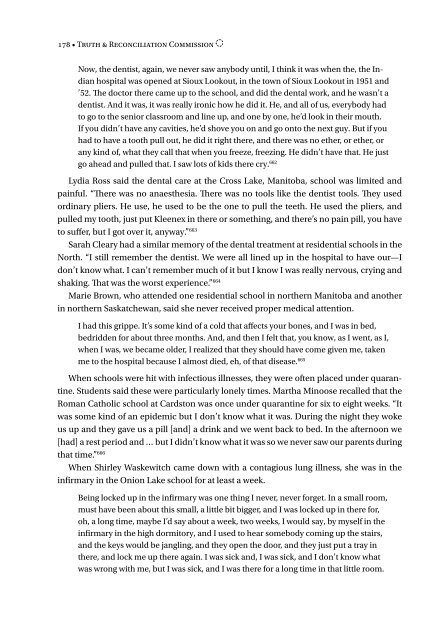The Survivors Speak
1MB8J05
1MB8J05
You also want an ePaper? Increase the reach of your titles
YUMPU automatically turns print PDFs into web optimized ePapers that Google loves.
178 • Truth & Reconciliation Commission<br />
Now, the dentist, again, we never saw anybody until, I think it was when the, the Indian<br />
hospital was opened at Sioux Lookout, in the town of Sioux Lookout in 1951 and<br />
’52. <strong>The</strong> doctor there came up to the school, and did the dental work, and he wasn’t a<br />
dentist. And it was, it was really ironic how he did it. He, and all of us, everybody had<br />
to go to the senior classroom and line up, and one by one, he’d look in their mouth.<br />
If you didn’t have any cavities, he’d shove you on and go onto the next guy. But if you<br />
had to have a tooth pull out, he did it right there, and there was no ether, or ether, or<br />
any kind of, what they call that when you freeze, freezing. He didn’t have that. He just<br />
go ahead and pulled that. I saw lots of kids there cry. 662<br />
Lydia Ross said the dental care at the Cross Lake, Manitoba, school was limited and<br />
painful. “<strong>The</strong>re was no anaesthesia. <strong>The</strong>re was no tools like the dentist tools. <strong>The</strong>y used<br />
ordinary pliers. He use, he used to be the one to pull the teeth. He used the pliers, and<br />
pulled my tooth, just put Kleenex in there or something, and there’s no pain pill, you have<br />
to suffer, but I got over it, anyway.” 663<br />
Sarah Cleary had a similar memory of the dental treatment at residential schools in the<br />
North. “I still remember the dentist. We were all lined up in the hospital to have our—I<br />
don’t know what. I can’t remember much of it but I know I was really nervous, crying and<br />
shaking. That was the worst experience.” 664<br />
Marie Brown, who attended one residential school in northern Manitoba and another<br />
in northern Saskatchewan, said she never received proper medical attention.<br />
I had this grippe. It’s some kind of a cold that affects your bones, and I was in bed,<br />
bedridden for about three months. And, and then I felt that, you know, as I went, as I,<br />
when I was, we became older, I realized that they should have come given me, taken<br />
me to the hospital because I almost died, eh, of that disease. 665<br />
When schools were hit with infectious illnesses, they were often placed under quarantine.<br />
Students said these were particularly lonely times. Martha Minoose recalled that the<br />
Roman Catholic school at Cardston was once under quarantine for six to eight weeks. “It<br />
was some kind of an epidemic but I don’t know what it was. During the night they woke<br />
us up and they gave us a pill [and] a drink and we went back to bed. In the afternoon we<br />
[had] a rest period and … but I didn’t know what it was so we never saw our parents during<br />
that time.” 666<br />
When Shirley Waskewitch came down with a contagious lung illness, she was in the<br />
infirmary in the Onion Lake school for at least a week.<br />
Being locked up in the infirmary was one thing I never, never forget. In a small room,<br />
must have been about this small, a little bit bigger, and I was locked up in there for,<br />
oh, a long time, maybe I’d say about a week, two weeks, I would say, by myself in the<br />
infirmary in the high dormitory, and I used to hear somebody coming up the stairs,<br />
and the keys would be jangling, and they open the door, and they just put a tray in<br />
there, and lock me up there again. I was sick and, I was sick, and I don’t know what<br />
was wrong with me, but I was sick, and I was there for a long time in that little room.


